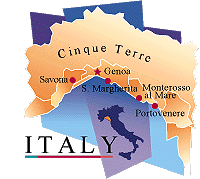|
|
 |
Cinque Terre is the name given to a part of the
eastern coast around the five small towns of Monterosso, Vernazza, Corniglia, Manarola,
and Riomaggiore. The towns are hard to reach, being hemmed in between the sea and the
mountains, and this has greatly helped in staving off the devastating impact of mass
tourism. Even today, the only way to get from one town to the other is along footpaths
that wind along the cliffs or by train. It takes about five hours to walk from the first
to the last of the five towns. Differences in landscape, soil, height, and agriculture has
created a tremendous variety of flora in the area. |
| FLORENCE
|
|
Florence is situated on the banks of the Arno river and set among low hills covered
with olive groves and vineyards. Founded in 200 BC as a colony of the Etruscan city of
Fiesole, Florence is the cradle of the Renaissance and home of Dante, Machiavelli,
Michelangelo and the Medici. |
| LECCE
|
|
A settlement of ancient origins, Lecce boasts the remains of an imposing Roman
amphitheatre and its own style of Baroque architecture. Lecce is both intellectual
and graceful as a city the past caressed by the winds of the Adriatci and Ionian seas. |
| VENICE
|
|
Perhaps no other city in the world has inspired so many writers as Venice (settling
began in the 5th century). It is a city of magic and mystery. Venice is best
experienced by getting lost in the narrow, winding streets. |
| ALBEROBELLO
|
|
This pretty town virtually exists for tourism. The buildings in the background are
Trullis. They are circular houses made of whitewashed stone w/o mortar, w/conical roofs.
The roofs are tiled w/concentric rows of slate. |
| SIENA
|
|
Siena is built on three hills and is still surrounded by its historic ramparts. Its
medeval centre is brisling w/majestic Gothic buildings and spirits of the past. |
| ROME/COLLAGE
|
|
There is just not enough room to even summarize the wonders of Rome. |